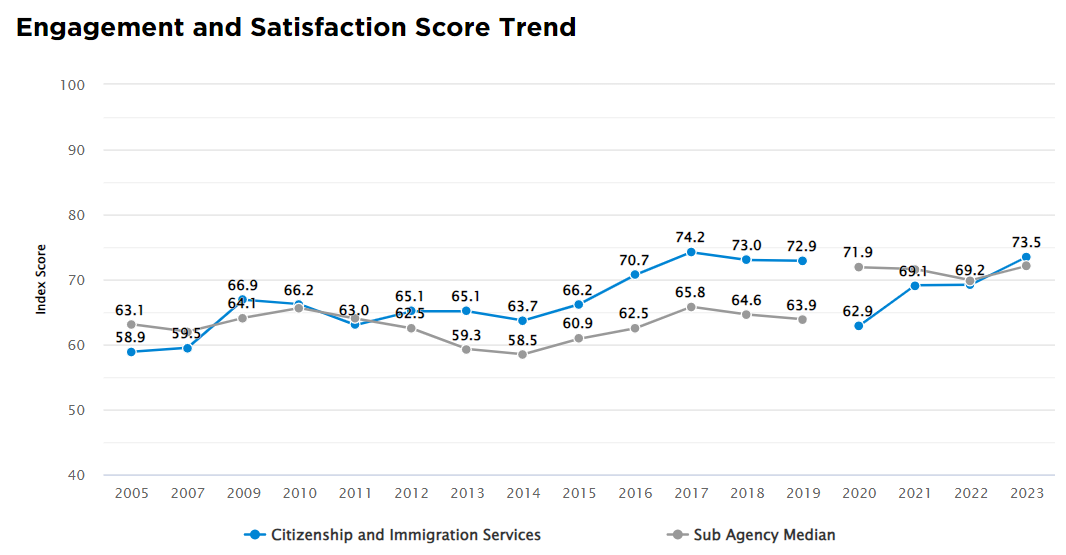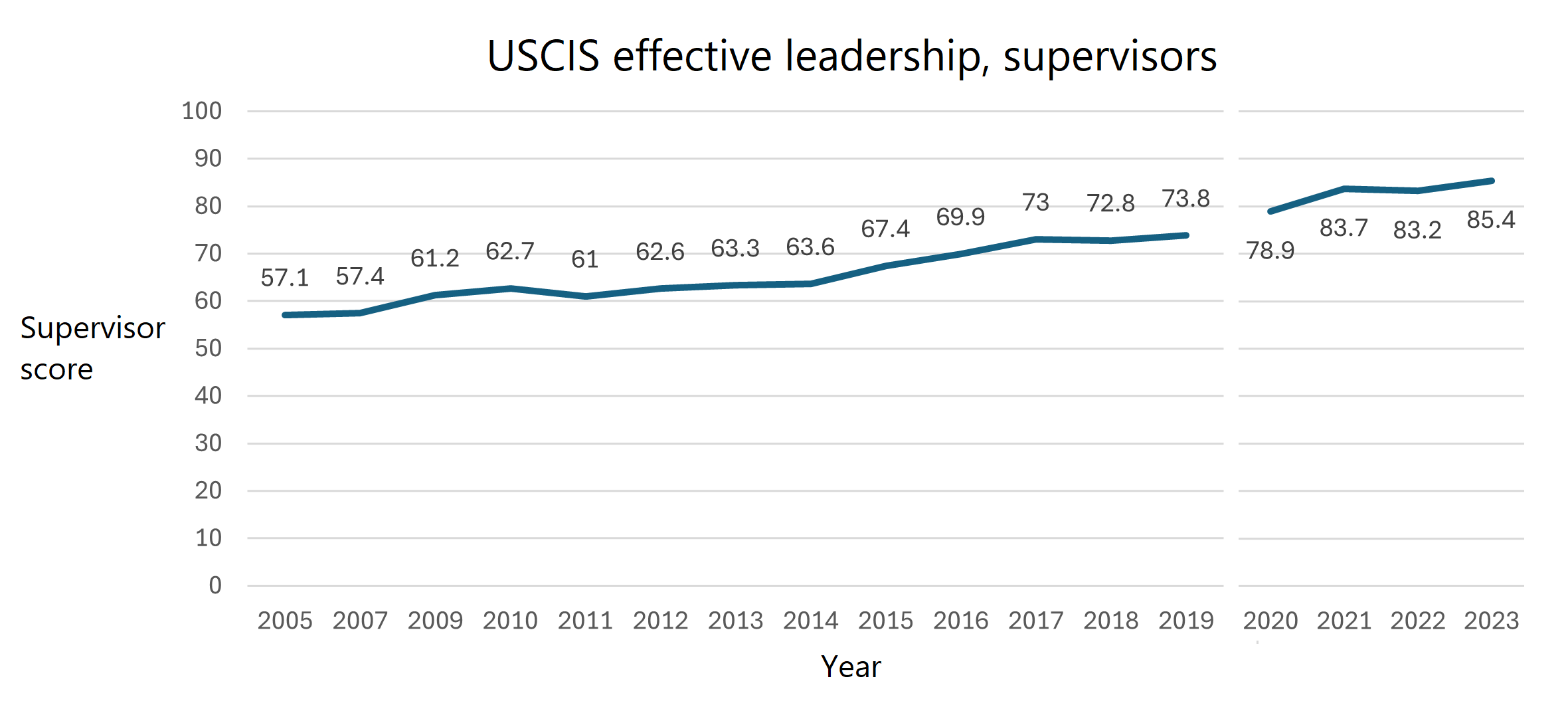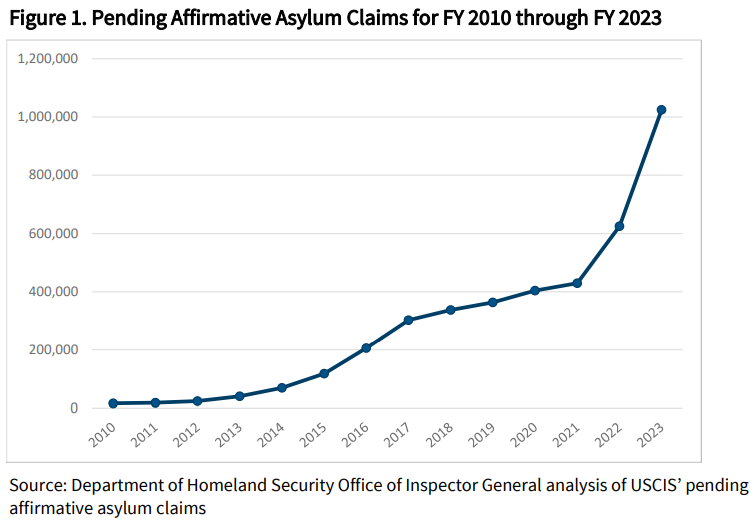Amid hiring issues, USCIS’ Jaddou aims to boost current workforce
Hiring remains a “substantial challenge” for USCIS, but a couple early signs indicate that the agency could be turning a corner with its current workforce.
Editor’s Note: This story is part of a DHS special report for Federal News Network. Check back for more interviews and content about DHS’ workforce engagement and satisfaction efforts throughout the week.
Several years after the end of a hiring freeze, the U.S. Citizenship and Immigration Services (USCIS) is still tackling ongoing staffing issues.
Hiring is a “substantial challenge” for USCIS, the Office of the Citizenship and Immigration Services ombudsman said in its 2024 report to Congress. Lingering effects of the hiring freeze that ended in 2021, as well as staff attrition and funding limitations, have hindered the agency’s ability to staff up, while workloads have grown for current agency employees.
USCIS’ current 21,267-member workforce is more than 3,000 positions short of the total staff size the agency is authorized to have.
“USCIS has said it continues its aggressive hiring to reduce the number of outstanding vacancies,” the ombudsman wrote in its report. “However, the agency is still at only 87.5% of its authorized capacity.”
Other signs, though, indicate that USCIS could be turning a corner for its current workforce. Employee engagement is on the rise. The agency was also one of the better-scoring Department of Homeland Security subcomponents in the 2023 Best Places to Work in the Federal Government rankings from the Partnership for Public Service.

USCIS Director Ur Jaddou is looking to make further adjustments to support a workforce that’s been grappling with many intersecting challenges — and starting by leaning in on more support for supervisors.
“Even where there is great supervisory support, and people are very satisfied with their supervisors, how do we take some of the pressure off the supervisors so they can even do better?” Jaddou said in an interview with Federal News Network. “It’s a very small number of people who naturally are great managers of people. So it is important to provide the support, the proper training — and we do it — the question is, how can we make it even better? And how can we continuously grow our managers, so that they can best serve the people on their team?”
Compared with its Best Places to Work scores from the past couple of years, USCIS appears to be on an upward trajectory. A 4.3-point increase in the agency’s employee engagement and satisfaction score landed the agency at an overall score of 73.5 out of 100 in the 2023 Best Places to Work. That puts USCIS above the Partnership’s governmentwide average score of 72.1 for agency subcomponents in 2023, though it’s still in the middle of the pack compared to other subcomponents across government.
Of all the workforce categories that the Partnership measures, USCIS’ highest scores were in employees’ perceptions of agency supervisors, as well as work-life balance.

On the other hand, USCIS scored relatively lower in Best Places to Work when it came to employee input and recognition. And that’s another area where Jaddou is hoping to make a difference going forward.
To try to encourage more employee feedback, USCIS has made town halls a regular occurrence, hosting them about once per quarter. About half of the agency’s workforce has attended town halls, either in person or virtually.

“It’s an opportunity to listen. People want to know that they’re being heard,” Jaddou said. “If [an employee has] a good idea, then great, let’s adopt it. If we think it’s not a good idea, let’s investigate, and if it doesn’t make sense for the agency as a whole, then we need to get back to the individual and explain why. And I have found that when you do that, it really takes the temperature out of the room.”
Before each town hall, employees can submit questions months in advance to ask to Jaddou and other agency leadership. Those questions are then put to a vote amid the workforce to determine what officials will address during the quarterly meetings.
“It’s a little bit like crowdsourcing. What questions do people want to hear?” Jaddou said. “The highest-ranked questions are the ones that are chosen … Some are bigger picture, larger questions about ensuring that people have flexibilities at work, wellness questions [or] pressures on the work they’re doing every day, wondering about the metrics that they have measuring their production.”

But Jaddou said questions and concerns from employees can also be quite specific. As an example, one common concern from USCIS employees has been the listing of immigration officers’ names on various immigration forms.
“There were some concerns about privacy there for our workforce, and obviously concerns about security [and] safety,” Jaddou said. “People don’t want their name out there potentially on a negative decision, it makes them nervous.”
After getting that regular feedback from staff, Jaddou said the agency made the decision to remove the officers’ names, aiming to better protect employees.
Addressing ongoing USCIS staffing issues
Still, major staffing issues, coupled with a hefty case backlog, have continued to challenge USCIS for years. Recent levels for the agency are unprecedented: Over 1 million asylum cases were pending determination at the end of fiscal 2023, the agency’s inspector general office reported. More than 786,000 of “affirmative” cases — those not involving removal proceedings — have been pending for longer than six months.

“This occurred because USCIS did not have sufficient funding, staffing and planning to complete its affirmative asylum caseload,” the IG said in a July 3 report.
In the absence of direct congressional appropriations, USCIS primarily uses application fees to fund the agency’s work. But in 2023, the IG said the fee-based revenue alone wasn’t enough to support the staffing needed to manage the workload.
“This shortage forced USCIS to prioritize certain types of work over resolving its backlog of affirmative asylum cases and also resulted in USCIS setting performance goals at levels too low to timely adjudicate new claims within the statutory limits and address the existing affirmative asylum backlog,” the IG said.
Adding to the challenge, USCIS staffing in its asylum division is insufficient to address the existing workload, the IG said. the agency still managed to handle more than 40,500 requests for immigration benefits each day. Additionally, during 2023, USCIS reduced the immigration backlog for the first time in a decade, something made even more notable after three successive years of an increasing caseload, the ombudsman said.
“That USCIS was able to decrease its pending caseloads at all is testament to its commitment to increase operational efficiencies and the dedication of staff to the agency’s mission,” the ombudsman said in its report. “A renewed focus on its digitization efforts, years in the making, enabled more accessibility of benefit requests, despite some setbacks. A staffing increase helped as new hires onboarded and were trained.”
The ombudsman said USCIS has faced unprecedented challenges over the last decade, but recommended numerous adjustments, such as reforms to the agency’s structure and staffing models, that may help the agency moving forward.
At the end of the day, the ombudsman said, “USCIS’ strongest asset has always been its workforce.”
Copyright © 2024 Federal News Network. All rights reserved. This website is not intended for users located within the European Economic Area.
Drew Friedman is a workforce, pay and benefits reporter for Federal News Network.
Follow @dfriedmanWFED






